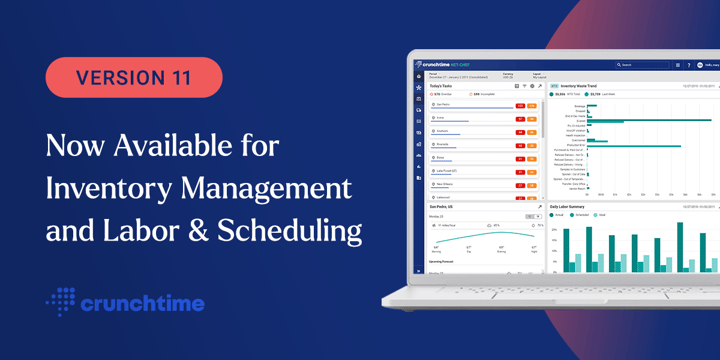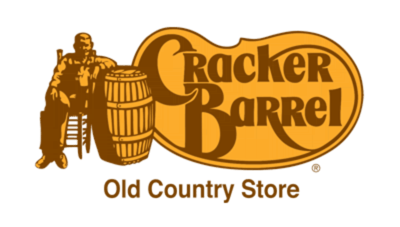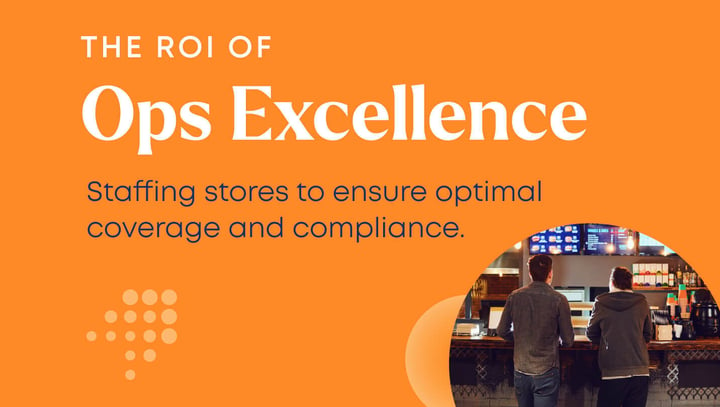
- Home
- Crunchtime Blog
- 9 Tips to Up Your Labor Scheduling Game from Restaurant Experts

9 Tips to Up Your Labor Scheduling Game from Restaurant Experts
Don't let scheduling slow your restaurant brand's growth. Use these pro tips to stay ahead.
For fast-growing restaurant brands, any opportunity to increase efficiencies is a win. But when it comes to managing labor, operators often face a series of roadblocks. Use these 9 tips from leaders in the food service industry to take back control of your labor and scheduling.
Tip #1: Measure the right metrics for labor
When it comes to cost control, operators can monitor a variety of different metrics using restaurant management software. However, not all data is created equal. Many operators rely on their labor cost percentage as a Northstar to guide cost control. Although a critical metric, it doesn’t always tell a full story of how well your stores are staffing shifts for labor optimization.
This is a key driver in Cotton Patch Cafe's labor strategy across their 45 store locations. “At Cotton Patch Cafe, we wanted to monitor our labor based on hours worked, and then make sure those hours were spread across shifts where we actually needed people, instead of just an overall labor cost percentage,” said Colby Baird, Director of Ops Excellence at Cotton Patch Cafe. “Crunchtime Labor & Scheduling provided that insight with its ideal hours metric, which was a key focus for our operation.”
After a shift is worked, using metrics like Earned vs. Actual Hours can help you understand how well you managed labor and help you avoid any staffing mishaps in the future. Labor is one of your highest variable costs, requiring constant oversight. Fortunately, measuring the right data points using labor and scheduling tools in your restaurant management software can put you back in the driver's seat.
Learn more about the best metrics that drive success in our latest ebook: Measuring What Matters
Tip #2 Consolidate your tech stack where it makes sense
A bloated tech stack is not conducive to an efficient restaurant operation. Each time you add a new software, you can expect to have more logins, more training, and more disparate data. Operators focused on growth should make every effort to consolidate their tech stack to improve efficiencies, increase data flow, and minimize costs.
For Cracker Barrel, this meant implementing both Crunchtime Inventory Management and Labor & Scheduling for their back of house operations. “The functionality of Crunchtime and the ability to combine our food and labor just made sense,” said Kim Tijerina, Food Systems Business Analyst, at Cracker Barrel.
Restaurants that manage their inventory and labor together within one restaurant management software platform have the unique advantage of controlling their two highest variable costs in one consolidated platform. This means one forecast to drive the food and labor operation and data consolidated on one single platform, for one version of the truth.
When evaluating new tech solutions, restaurants should pay close attention to which tech providers offer complete capabilities in multiple areas. An efficient tech stack will give your restaurant a competitive edge and position your brand to thrive in the future.

Tip #3 Prove your new scheduling platform at a select number of locations first
Anytime you implement a new tech solution, adoption is key. But it can be tricky to achieve buy-in across the organization. No operator wants to experience a disruption in their daily operations, especially with staffing and labor management. If you make a major change to your operation, like implementing a new software, you need to demonstrate the positive impact it will have.
Understanding the importance of this, Five Guys chose to implement Crunchtime Labor & Scheduling at its corporate locations first. “We rolled out Crunchtime at 500 or so corporate locations first. Then we had something to show our franchisees that it worked,” said George Anthony, System Administrator at Five Guys.
If you can clearly demonstrate how your new software will provide value and make your managers’ lives easier, adoption will happen faster across all your store locations. Embracing change can be difficult at first, but if you take the lead to demonstrate, you can build trust faster across the organization.
Tip #4 Get feedback from your managers when rolling out a new scheduling platform
Cracker Barrel took a similar approach to Five Guys and rolled out their new scheduling platform in strategic phases across stores. To help make the adoption even more successful, they used multiple test groups and sought feedback from store managers so they could address any roadblocks proactively.
“After testing Crunchitme in one Cracker Barrel store, we moved into another state and a larger district. The feedback was invaluable. Managers could tell us what they did or didn’t like, as well as what saved them time,” said Tijerina.
From there, Cracker Barrel scaled the rollout and implemented Crunchtime at 300 stores over one weekend. When Tijerina and her colleagues returned to work on Monday morning, they were pleased to find that the rollout was a success. She credits much of that success to the feedback they received from different store managers.
Tip #5 Create staffing level templates that will fit each store’s needs
Labor requirements differ across the restaurant industry. For instance, a QSR and full-service dining will likely have different labor costs and different labor goals. Meanwhile, some areas have to follow Fair Workweek ordinances which can make scheduling an even more challenging task.
Five Guys understood that there's no “one-size-fits-all solution to staffing, so they prioritized flexible staffing level templates when they implemented a new scheduling solution. They wanted each franchisee to be able to create and customize staffing templates that would fit their needs.
“Our franchisees needed the flexibility to adjust their staffing templates because they are all their own business owners,” said Anthony. “Some franchisees are very focused on the service aspect and run closer to 25% while some might have a more tenured staff so they can run their labor lower.”
When it was time to implement, Five Guys took a hands-on approach. They went into the field and provided franchisees with guides on how to customize the staffing level templates to fit each of the store’s needs. Once the operators realized they could customize and tailor the schedules, software adoption became much easier.
.png?width=380&height=99&name=FiveGuys-QSR%20(2).png)
Tip #6: Schedule on-the-go with a mobile app
Time is money in the restaurant industry and managing schedules can be a seriously time-consuming task for both managers and teams. The best way to eliminate wasted scheduling time is to use a mobile app for scheduling.
For Cracker Barrel, Crunchtime’s mobile scheduling app has been a game changer for time management. “The managers have everything they need right in their pocket. They can approve or deny shift changes in the palm of their hand,” said Tijerina.
Both employees and managers will benefit from the ability to schedule on-the-go and it is the easiest way to keep teams aligned and get full coverage for every shift. If you are manually managing changes to the schedule with a spreadsheet or through email, it’s likely time to consider automation.
Tip #7: Track how much time your managers spend on scheduling
Whether you use a mobile scheduling app or not, you should pay attention to the amount of time that managers spend creating schedules and managing changes each week. If the time exceeds a few hours a week, there’s likely room for improvement.
At Cotton Patch Cafe, managers spend about an hour total each week on scheduling. “Having everything for scheduling right at your fingertips makes everything easier,” said Colby. And spending any more time than that would probably be too much in Colby's view.
Remember, the less time your managers are tied up in the back office, the more time they have to spend with guests on the store floor, improving the customer experience. If you aren't sure how much time managers are spending on schedules, consider monitoring that task and see where you can improve efficiencies.

Tip #8: Automate tip pooling
Tip pooling has gained popularity across the restaurant industry and has become an attractive incentive for recruiting restaurant workers. During Covid, Five Guys needed a better process for accepting and distributing tips at the point of sale. It was critical that the stores could automatically calculate the tip pool and distribute the tips to each employee on their paycheck.
“Having tip pooling in Crunchtime is a big deal. It’s one less step and one less work for everybody,” said Anthony.
If your store managers are trying to manually calculate and distribute the tip pool, they are likely losing valuable time. There's also a higher chance of mistakes when manual methods are used. Whether your operation currently collects tips at the point of sale or you're considering it in the future, make sure you automate this process to the highest degree possible to save your team valuable time.
Tip# 9: Enable managers to collaborate on schedule building
Scheduling can be especially challenging for restaurants with a large staff or stores with multiple managers working simultaneously. It doesn’t hurt to get some help from time to time, but you need to make sure your managers don't lose any unsaved changes or duplicate efforts when they work together on a schedule.
A scheduling platform that offers collaborative schedule editing can make this possible for your restaurant. Two managers can work on the same schedule simultaneously without losing changes. For Cracker Barrel, this opened up an opportunity to collaborate more efficiently and save time. “It has been super helpful because both managers are now in the schedule at the same time without any issues,” said Tijerina.
When it comes to efficient scheduling, don't underestimate the power of collaboration. The ability to work together on schedules is especially useful for restaurants with a large staff, or for stores with multiple managers working at once.
![]()
About the Experts in this Article
The tips in this article were taken from a live panel discussion at the 2023 Crunchtime Ops Summit, where three restaurant industry experts shared best practices and advice on efficient labor and scheduling. The panel was comprised of the following thought leaders:
- Colby Baird, Director of Ops Excellence at Cotton Patch Cafe
- George Anthony, System Administrator at Five Guys
- Kim Tijerina, Food Systems Business Analyst, Cracker Barrel
Ready to learn more tips like this from industry experts?
Save the date for our next user conference—Ops Summit 2024 will be held November 13-14 in Boston, MA. Stay tuned for more details on the agenda, lodging, and more. If you didn't join us last year, take a look at our 2023 event recap to see what you missed.
Share this post
Related


The ROI of Ops Excellence: How Restaurants Can Measure the Value of Better Scheduling and Labor Management


